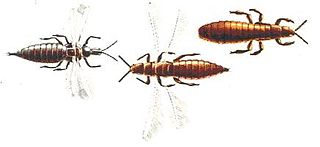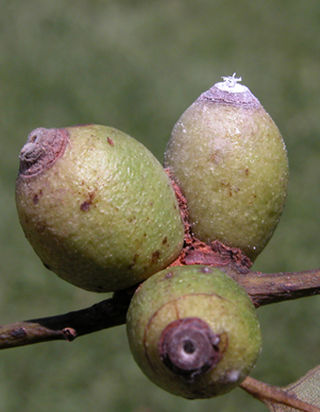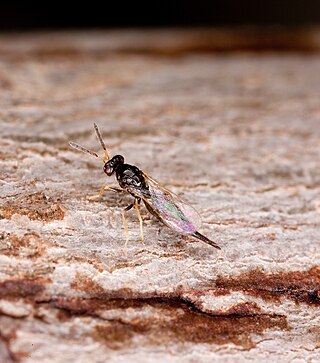
Thrips are minute, slender insects with fringed wings and unique asymmetrical mouthparts. Entomologists have described approximately 7,700 species. They fly only weakly and their feathery wings are unsuitable for conventional flight; instead, thrips exploit an unusual mechanism, clap and fling, to create lift using an unsteady circulation pattern with transient vortices near the wings.

Scale insects are small insects of the order Hemiptera, suborder Sternorrhyncha. Of dramatically variable appearance and extreme sexual dimorphism, they comprise the infraorder Coccomorpha which is considered a more convenient grouping than the superfamily Coccoidea due to taxonomic uncertainties. Adult females typically have soft bodies and no limbs, and are concealed underneath domed scales, extruding quantities of wax for protection. Some species are hermaphroditic, with a combined ovotestis instead of separate ovaries and testes. Males, in the species where they occur, have legs and sometimes wings, and resemble small flies. Scale insects are herbivores, piercing plant tissues with their mouthparts and remaining in one place, feeding on sap. The excess fluid they imbibe is secreted as honeydew on which sooty mold tends to grow. The insects often have a mutualistic relationship with ants, which feed on the honeydew and protect them from predators. There are about 8,000 described species.

Saturniidae, members of which are commonly named the saturniids, is a family of Lepidoptera with an estimated 2,300 described species. The family contains some of the largest species of moths in the world. Notable members include the emperor moths, royal moths, and giant silk moths.

Casuarina is a genus of flowering plants in the family Casuarinaceae, and is native to Australia, the Indian subcontinent, Southeast Asia, islands of the western Pacific Ocean, and eastern Africa. Plants in the genus Casuarina are monoecious or dioecious trees with green, pendulous, photosynthetic branchlets, the leaves reduced to small scales arranged in whorls around the branchlets, the male and female flowers arranged in separate spikes, the fruit a cone containing grey or yellowish-brown winged seeds.

Cecidomyiidae is a family of flies known as gall midges or gall gnats. As the name implies, the larvae of most gall midges feed within plant tissue, creating abnormal plant growths called galls. Cecidomyiidae are very fragile small insects usually only 2–3 mm (0.079–0.118 in) in length; many are less than 1 mm (0.039 in) long. They are characterised by hairy wings, unusual in the order Diptera, and have long antennae. Some Cecidomyiids are also known for the strange phenomenon of paedogenesis in which the larval stage reproduces without maturing first. In some species, the daughter larvae consume the mother, while in others, reproduction occurs later on in the egg or pupa.

Papilio protenor, the spangle, is a butterfly found in India belonging to the swallowtail family.

The Mymaridae, commonly known as fairyflies or fairy wasps, are a family of chalcidoid wasps found in temperate and tropical regions throughout the world. The family contains around 100 genera with 1,400 species.

The bush coconut, or bloodwood apple, is an Australian bush tucker food. It is an insect gall with both plant and animal components: an adult female scale insect and her offspring live in a gall induced on a bloodwood eucalypt tree (Corymbia). Bush coconuts can vary from golf ball to tennis ball size. They have a hard and lumpy outer layer. The inner layer is a white flesh that contains the female insect and her offspring. There are three known species of Cystococcus responsible for forming the bush coconut: Cystococcus pomiformis, Cystococcus echiniformis and Cystococcus campanidorsalis. C. pomiformis is the most common species. The bush coconut is found in Western Australia, the Northern Territory, Queensland and New South Wales.

Timema is a genus of relatively short-bodied, stout and wingless stick insects native to the far western United States, and the sole extant member of the family Timematidae. The genus was first described in 1895 by Samuel Hubbard Scudder, based on observations of the species Timema californicum.
Paratachardina pseudolobata, the lobate lac scale, is a polyphagous and pestiferous lac scale insect, which damages trees and woody shrubs in Cuba, Florida, the Bahamas and the Australian territory of Christmas Island. It was mistakenly identified as Paratachardina lobata (Chamberlin), an insect native to India and Sri Lanka, but was in 2007 recognized and named as a distinct species based on material from Florida; its native distribution is as yet unknown. The new lac insect was described based on all stages of the female, during the revision of the genus Paratachardina, wherein all its known species were redescribed.

Eriococcidae is a family of scale insects in the order Hemiptera. They are commonly known as felt scales or eriococcids. As of 2023, there are 109 genera and 681 species. Each species is usually specific to a different plant host, or closely related group of hosts.

Cerococcidae is a family of scale insects commonly known as ornate pit scales or cerococcids. There are 83 species in 5 genera. Members of this family occur in all regions of the world.

Monophlebidae is a family of scale insects commonly known as the giant scales or monophlebids. They occur in most parts of the world but more genera are found in the tropics than elsewhere.
Putoidae is a family of scale insects commonly known as giant mealybugs or putoids. There is probably a single genus, Puto, containing about sixty species. The genus name Macrocerococcus has also been used but it is now considered to be a synonym of Puto. The genus Puto was formerly classified as a member of the Pseudococcidae; however, it so significantly differed from the rest of the Pseudococcidae that it was accorded its own family Putoidae.

The Ibaliidae are a small family of hymenopteran superfamily Cynipoidea. Ibaliidae differ from most of the cynipoids by the larvae being parasitoids on other wasp larvae in the group Siricidae. The Ibaliidae comprise three extant genera of fairly large wasps, with a total of 20 species, and is a sister group to the rest of the cynipoids except the small subfamily Austrocynipidae.

Apiomorpha is a genus of scale insect that induces galls on species of Eucalyptus. Galls are initiated by first-instar nymphs (crawlers) on new plant growth and, when mature, the galls exhibit marked sexual dimorphism. Those induced by females are among the largest and most spectacular of arthropod-induced galls whereas those of males are small and most are tubular. Apiomorpha is known only from Australia and New Guinea although its host, Eucalyptus, has a wider distribution into Indonesia as well.

Callococcus is a genus of Australian scale insect that feeds on species of Leptospermum, Hypocalymma, Kunzea and some other members of the tribes Chamelaucieae and Leptospermeae in the myrtle family Myrtaceae. Callococcus leptospermi induces stem-swelling galls on some species of Leptospermum, and it is considered to be a potential biological control agent of Leptospermum laevigatum in South Africa. The other described species of Callococcus do not induce galls.
Gallacoccus is a genus of the scale insects commonly known as beesoniids. They typically cause galls on their plant hosts. Gallacoccus anthonyae is the type species. Female members of the genus Gallacoccus have only three instars, in contrast to the other beesoniid genera where the females have four.

Tetrastichinae is a subfamily of the chalcid wasp family Eulophidae. It is one of the largest subfamilies of the Eulophidae containing over 100 genera and nearly 3,000 species. The species of the family Tetrastichinae are found in almost any type of terrestrial habitat and have a worldwide distribution, except Antarctica. They show a varied biology and hosts for Tetrastichinae wasps have been identified from over 100 different insect families, across 10 different orders and they have also been recorded as being parasitoids on nematodes, mites and spiders' eggs. Some species are even phytophagous, while others are inquilines and yet others are gall formers.

Paracantha gentilis is a species of tephritid or fruit fly in the genus Paracantha of the family Tephritidae. It has a widespread distribution throughout the Western United States, and has also been found as far south as Mexico and Costa Rica. It most closely resembles Paracantha culta, which is widespread in the Southeastern United States, but P. gentilis can be distinguished by having smaller spots on the head.

















